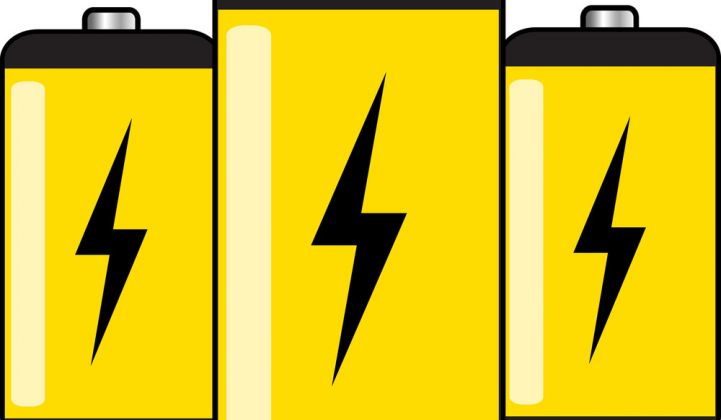Here’s a remarkable statistic from the new U.S. Energy Storage Monitor report, one that indicates that behind-the-meter batteries may be hitting a new stage in growth, at least in the state that offers the best combination of incentives and future opportunities.
That state is California, which added 11 megawatts of commercial behind-the-meter battery systems in the third quarter of 2015. That’s more than half the state’s entire installed base to date, deployed in just three months, according to Thursday’s report from GTM Research and the Energy Storage Association.
That 11 megawatts also made up the lion's share of the U.S. total of 13.7 megawatts of behind-the-meter systems, compared to a mere 700 kilowatts deployed in the same quarter last year. These are startling growth rates, compared to the more stable doubling of utility-scale, or “front-of-the-meter,” storage deployments -- from 28.3 megawatts to 46.6 megawatts -- that took place over the same period.
Over the same time, the behind-the-meter segment has grown from 14 percent to 23 percent of the country’s total storage capacity, the report notes. All told, the U.S. deployed 60.3 megawatts of energy storage in the third quarter, up from 29.2 megawatts in the same quarter last year. (GTM Research analyst and ESM co-author Ravi Manghani will be unpacking the implications of these and other storage trends at next week's U.S. Energy Storage Summit in San Francisco -- learn more about the conference or view the livestream.)
California’s behind-the-meter battery boom is being fueled by the state’s Self-Generation Incentive Program (SGIP), which pays for up to 60 percent of the cost of qualifying projects. "The huge pipeline of approved SGIP projects has finally started to see completion at a steady pace," Manghani said. "There are some headwinds, as the California PUC might be suspending the SGIP program briefly in 2016. But it won't necessarily impact deployments straightaway." Still, "There's a little bit of uncertainty, as the CPUC is scheduled to revise eligibility criteria," he noted, as part of its ongoing work to incorporate greenhouse-gas reduction for incentive-winning projects.
SGIP payouts have helped bolster the underlying business case for behind-the-meter batteries -- reducing demand charges, which can add up to about half of a commercial or industrial customer’s utility bill, by smoothing out spikes and peaks in grid power demand. Batteries can do this on their own, as companies like Stem, Green Charge Networks, and Tesla have been proving with commercial deployments in California. Or they can pair up with commercial rooftop solar, as Tesla is doing with SolarCity, or Green Charge is doing with SunEdison, or Stem is doing with SunPower, to name a few of the partnerships active in the state.
For residential customers, the main selling point for batteries from Tesla, Sunverge, Sonnenbatterie and others is backup power. But there's potential for a number of other future benefits, like storing midday rooftop solar power for use during afternoons when grid prices peak. In Hawaii, where net metering has been replaced by new regulations that limit rooftop solar’s value as a grid export, self-storage is also becoming a worthy economic case. In the past quarter, Hawaii’s residential storage deployments have boomed, now making up 33 percent of the U.S. total of 3.4 megawatt-hours deployed, the report notes.
Utilities are another driver for behind-the-meter battery growth. Southern California Edison inked long-term procurement contracts for more than 100 megawatts of behind-the-meter storage to be deployed over the next five years from companies including Stem, Advanced Microgrid Solutions, Ice Energy and NRG Energy. Looking further ahead, California is also starting to open grid programs and markets to aggregated distributed storage assets.
California’s boom also helped bolster the duration value of storage being deployed across the country, according to the megawatt-hour data now included in the Energy Storage Monitor report. About 28 megawatt-hours of behind-the-meter systems were deployed in the third quarter, more than half of the quarter’s 53-megawatt-hour total, and up from a mere 1.7 megawatt-hours in the same quarter last year.
GTM Research and ESA plan to include megawatt-hour figures in reports going forward, which requires some extra explanation. Take the third quarter’s utility-scale, or “front-of-the-meter,” storage deployment figures, which rose on an annual basis from 28.3 megawatts to 46.6 megawatts, but fell from 46.6 megawatt-hours to 25 megawatt-hours over the same period.
How can an energy storage portfolio increase in megawatts, but decrease in megawatt-hours, you might ask? The answer, it turns out, is that the third quarter’s front-of-meter projects were largely short-duration frequency regulation projects for mid-Atlantic grid operator PJM -- high in megawatts, but in 30-minute or 15-minute durations that halve or quarter their megawatt-hour ratings. Meanwhile, one massive project, Southern California Edison’s Tehachapi wind energy storage project, added 36 megawatt-hours in the third quarter of 2014, skewing the figures for comparison.



